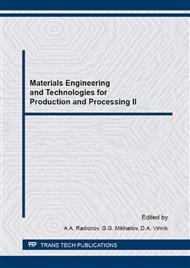[1]
E. Bernardo, F. Albertini, Glass foams from dismantled cathode ray tubes, Ceramics International. 32 (2006) 603-608.
DOI: 10.1016/j.ceramint.2005.04.019
Google Scholar
[2]
C. Mugoni, M. Montorsi, C. Siligardi, Design of glass foams with low environmental impact, Ceramics International. 41 (2015) 3400-3408.
DOI: 10.1016/j.ceramint.2014.10.127
Google Scholar
[3]
E. Bernardo, R. Cedro, M. Florean, Reutilization and stabilization of wastes by the production of glass foams, Ceramics International. 33 (2006) 963-968.
DOI: 10.1016/j.ceramint.2006.02.010
Google Scholar
[4]
F. Méar, P. Yot, M. Ribes, Effects of temperature, reaction time and reducing agent content on the synthesis of macroporous foam glasses from waste funnel glasses, Materials Letters. 60 (2006) 929-934.
DOI: 10.1016/j.matlet.2005.10.046
Google Scholar
[5]
P. Yot, F. Méar, Characterization of lead, barium and strontium leachability from foam glasses elaborated using waste cathode ray-tube glasses, Journal of Hazardous Materials. 185 (2011) 236-241.
DOI: 10.1016/j.jhazmat.2010.09.023
Google Scholar
[6]
Q. Xu, G. Li, W. He, Cathode ray tube (CRT) recycling: Current capabilities in China and research progress, Waste Management. 32 (2012) 1566-1574.
DOI: 10.1016/j.wasman.2012.03.009
Google Scholar
[7]
Q. Xu, M. Yu, A. Kendall, Environmental and economic evaluation of cathode ray tube (CRT) funnel glass waste management options in the United States, Resources, Conservation and Recycling. 78 (2013) 92-104.
DOI: 10.1016/j.resconrec.2013.07.001
Google Scholar
[8]
L. Ding, W. Ning, Q. Wang, Preparation and characterization of glass-ceramic foams from blast furnace slag and waste glass, Materials Letters. 141 (2015) 327-329.
DOI: 10.1016/j.matlet.2014.11.122
Google Scholar
[9]
I. Ponsot, E. Bernardo, Self glazed glass ceramic foams from metallurgical slag and recycled glass, Journal of Cleaner Production. 59 (2013) 245-250.
DOI: 10.1016/j.jclepro.2013.06.029
Google Scholar
[10]
M. Suzuki, T. Tanaka, N. Yamasaki, Use of hydrothermal reactions for slag/glass recycling to fabricate porous materials, Current Opinion in Chemical Engineering. 3 (2014) 7-12.
DOI: 10.1016/j.coche.2013.08.006
Google Scholar
[11]
H. Fernandes, D. Tulyaganov, J. Ferreira, Preparation and characterization of foams from sheet glass and fly ash using carbonates as foaming agents, Ceramics International. 35 (2009) 229-235.
DOI: 10.1016/j.ceramint.2007.10.019
Google Scholar
[12]
Y. Zhao, J. Ye, X. Lu, Preparation of sintered foam materials by alkali-activated coal fly ash, Journal of Hazardous Materials. 174 (2010) 108-112.
DOI: 10.1016/j.jhazmat.2009.09.023
Google Scholar
[13]
V.E. Manevich, K. Yu. Subbotin, Foam glass and problems of energy conservation, Glass and Ceramics. 65 (2008) 105-108.
DOI: 10.1007/s10717-008-9026-1
Google Scholar
[14]
O.V. Kaz'mina, M.A. Dushkina, M.V. Chubik, Bioresistance of foam-glass crystal materials to filamentous fungi, Glass and Ceramics. 70 (2014) 333-337.
DOI: 10.1007/s10717-014-9575-4
Google Scholar
[15]
O.V. Kaz'mina, V.I. Vereshchagin, A.N. Abiyaka, Assessment of the compositions and components for obtaining foam-glass-crystalline materials from aluminosilicate initial materials, Glass and Ceramics. 66 (2009) 82-85.
DOI: 10.1007/s10717-009-9133-7
Google Scholar
[16]
O.V. Kaz'mina, V.I. Vereshchagin, A.N. Abiyaka, Temperature regimes for obtaining granular material for foamed crystal glass materials as a function of the batch composition, Glass and Ceramics. 66 (2009) 179-182.
DOI: 10.1007/s10717-009-9160-4
Google Scholar
[17]
O.V. Puchka, N.I. Min'ko, M.N. Stepanova, Foam-glass based composite heat-insulating material with a protective-decorative coating on the front surface, Glass and Ceramics. 66 (2009) 43-45.
DOI: 10.1007/s10717-009-9119-5
Google Scholar
[18]
E.A. Yatsenko, V.A. Smolii, A.S. Kosarev, Physical-chemical properties and structure of foamed slag glass based on thermal power plant wastes, Glass and Ceramics. 70 (2013) 3-6.
DOI: 10.1007/s10717-013-9496-7
Google Scholar
[19]
E.A. Yatsenko, A.P. Zubekhin, B.M. Gol'tsman, Investigation of the factors influencing the properties and structure of foamed slag glass, Glass and Ceramics. 71 (2014) 111-114.
DOI: 10.1007/s10717-014-9630-1
Google Scholar
[20]
E.A. Yatsenko, A.P. Zubekhin, V.A. Smolii, Resource-conserving technology of heat-insulation-decorative glass-composite material based on ash-slag wastes, Glass and Ceramics. 72 (2015) 216-219.
DOI: 10.1007/s10717-015-9759-6
Google Scholar
[21]
E.A. Yatsenko, B.M. Goltsman, V.A. Smolii, Investigation of the influence of foaming agents' type and ratio on the foaming and reactionary abilities of foamed slag glass, Biosciences Biotechnology Research Asia. 12 (2015) 625-632.
DOI: 10.13005/bbra/2242
Google Scholar
[22]
E.A. Yatsenko, B.M. Goltsman, V.A. Smolii, Foamed slag glass - unique insulating material, in: Biotechnology, Agriculture, Environment and Energy: proceedings of the international conference (ICBAEE 2014), 22-23 may 2014, Beijing, China – London: Taylor and Francis Group, 2015, pp.389-391.
DOI: 10.1201/b17720-86
Google Scholar
[23]
E.A. Yatsenko, B.M. Goltsman, V.A. Smolii, Foamed glass based on slag wastes, Journal of International Scientific Publications: Materials, Methods and Technologies. 8 (2014) 54-61.
Google Scholar
[24]
E.A. Yatsenko, B.M. Goltsman, V.A. Smolii, Foamed slag glass - eco-friendly insulating material based on slag waste, in: Proceedings of 2015 IEEE 15th International Conference on Environment and Electrical Engineering (EEEIC), 2015, pp.819-823.
DOI: 10.1109/eeeic.2015.7165270
Google Scholar
[25]
E.A. Yatsenko, V.A. Smolii, A.S. Kosarev, Аpplication of mathematical modeling for studying the strength properties of foamed slag glass, Glass and Ceramics. 68 (2011) 91-94.
DOI: 10.1007/s10717-011-9329-5
Google Scholar
[26]
E.A. Yatsenko, B.M. Goltsman, L.A. Yatsenko, Investigation of the Raw Materials' Composition and Ratio Influence on the Structure and Properties of the Foamed Slag Glass, Materials Science Forum. 843 (2016) 183-188.
DOI: 10.4028/www.scientific.net/msf.843.183
Google Scholar


